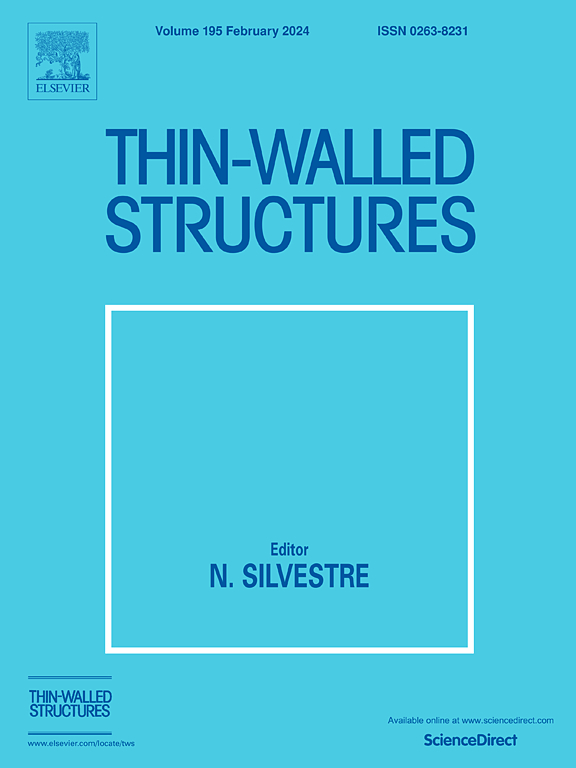Synergistic gradient-composite effects on mechanical reinforcement of ceramic lattice structures
IF 6.6
1区 工程技术
Q1 ENGINEERING, CIVIL
引用次数: 0
Abstract
The balance between lightweight design and structural strength in the pressure hull of underwater vehicles remains a critical technical challenge. In this study, gradient ceramic lattice structures (GCLSs) were proposed and fabricated via stereolithography (SL) additive manufacturing. A biomimetic composite structure (GCLS/PR) was developed by integrating phenolic resin (PR) into the GCLSs through a vacuum infiltration process. Through quasi-static compression experiments combined with numerical simulations, the effects of gradient design and composite strategies on the mechanical performance of the structures were systematically investigated. Experimental results reveal that positive gradient design significantly enhances energy absorption efficiency through a periphery-to-core progressive failure mode. Specifically, under positive gradient design, the compressive strength and energy absorption of the body-centered cubic (BCC) structure increased by ∼2.01 times and ∼1.69 times, respectively, compared to non-gradient designs, while those of the octet (OCT) structure improved by ∼1.73 times and ∼1.29 times. The incorporation of PR induced a synergistic strengthening effect, with GCLS/PR achieving up to ∼17.82-time enhancements in compressive strength and ∼167.49-time improvements in energy absorption in comparison to monolithic GCLS. These improvements arise primarily from the stress-transfer efficiency of PR and its protective encapsulation mechanism for fractured struts. The synergistic gradient-composite design strategy significantly enhances the overall performance of ceramic materials, offering a novel technical paradigm for the advancement of the pressure hull materials.

陶瓷晶格结构力学增强的协同梯度复合效应
水下航行器耐压外壳的轻量化设计和结构强度之间的平衡仍然是一个关键的技术挑战。在本研究中,梯度陶瓷晶格结构(gcls)被提出并通过立体光刻(SL)增材制造制造。通过真空渗透工艺将酚醛树脂(PR)注入GCLS中,制备了一种仿生复合结构(GCLS/PR)。通过准静态压缩试验和数值模拟相结合的方法,系统研究了梯度设计和复合策略对结构力学性能的影响。实验结果表明,正梯度设计通过外围到核心的递进破坏模式显著提高了能量吸收效率。具体而言,在正梯度设计下,体心立方(BCC)结构的抗压强度和能量吸收分别比非梯度设计提高了~ 2.01倍和~ 1.69倍,而八元体(OCT)结构的抗压强度和能量吸收分别提高了~ 1.73倍和~ 1.29倍。PR的掺入诱导了协同强化效应,与单片GCLS相比,GCLS/PR的抗压强度提高了~ 17.82倍,能量吸收提高了~ 167.49倍。这些改善主要来自于PR的应力传递效率及其对破裂支柱的保护封装机制。这种协同梯度复合设计策略显著提高了陶瓷材料的整体性能,为耐压壳体材料的发展提供了一种新的技术范式。
本文章由计算机程序翻译,如有差异,请以英文原文为准。
求助全文
约1分钟内获得全文
求助全文
来源期刊

Thin-Walled Structures
工程技术-工程:土木
CiteScore
9.60
自引率
20.30%
发文量
801
审稿时长
66 days
期刊介绍:
Thin-walled structures comprises an important and growing proportion of engineering construction with areas of application becoming increasingly diverse, ranging from aircraft, bridges, ships and oil rigs to storage vessels, industrial buildings and warehouses.
Many factors, including cost and weight economy, new materials and processes and the growth of powerful methods of analysis have contributed to this growth, and led to the need for a journal which concentrates specifically on structures in which problems arise due to the thinness of the walls. This field includes cold– formed sections, plate and shell structures, reinforced plastics structures and aluminium structures, and is of importance in many branches of engineering.
The primary criterion for consideration of papers in Thin–Walled Structures is that they must be concerned with thin–walled structures or the basic problems inherent in thin–walled structures. Provided this criterion is satisfied no restriction is placed on the type of construction, material or field of application. Papers on theory, experiment, design, etc., are published and it is expected that many papers will contain aspects of all three.
 求助内容:
求助内容: 应助结果提醒方式:
应助结果提醒方式:


